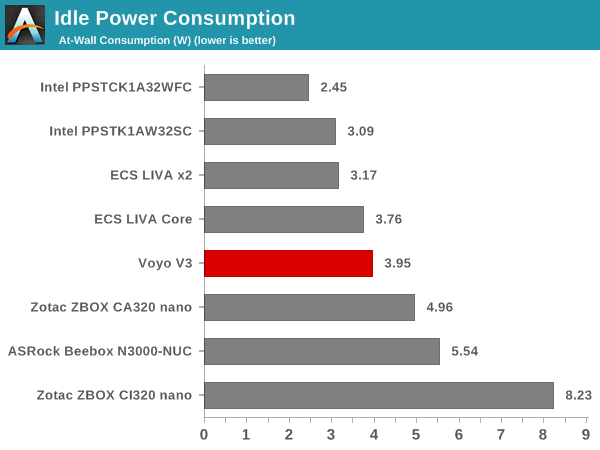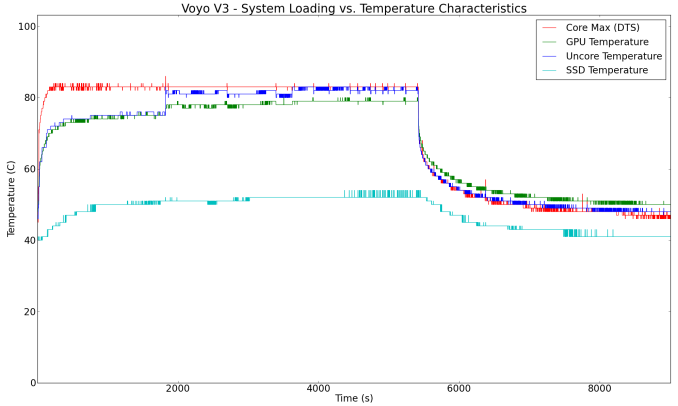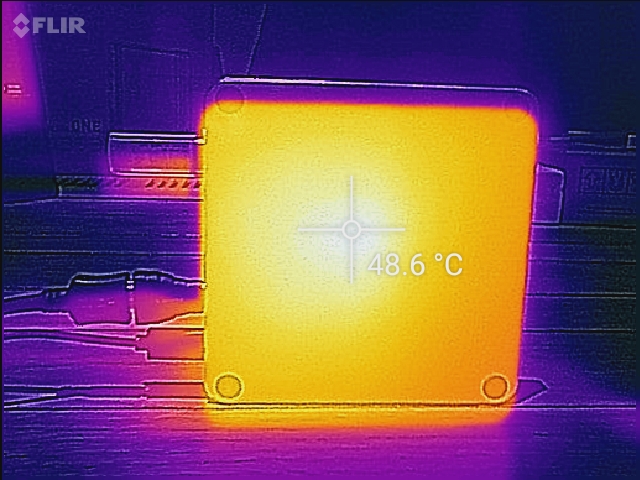Voyo V3 Review - A Fanless Intel Atom x7-Z8700 (Cherry Trail) mini-PC
by Ganesh T S on March 1, 2016 8:00 AM EST- Posted in
- Systems
- Intel
- Atom
- Passive Cooling
- Mini-PC
- Cherry Trail
Power Consumption and Thermal Performance
The power consumption at the wall was measured with a 1080p display being driven through the HDMI port. In the graphs below, we compare the idle and load power of the Voyo V3 with other low power PCs evaluated before. For load power consumption, we ran Furmark 1.12.0 and Prime95 v27.9 together. Given that the BIOS of the machine is not really optimized, the idle power being more than most comparable PCs is not surprising.


The load power consumption numbers can also be easily explained. The Atom x7-Z8700 has a SDP of only 2W, and it is definitely less power hungry compared to the Intel Celeron N3000 in the ASRock Beebox. However, it does lose out to the Bay Trail Compute Stick - this could be due to the power consumption of the extra components on the board such as the PCIe - SATA bridge and the faster clocks in the Cherry Trail SoC.
Our thermal stress routine starts with the system at idle, followed by 30 minutes of pure CPU loading. This is followed by another 30 minutes of both CPU and GPU being loaded simultaneously. After this, the CPU load gets removed, allowing the GPU to be loaded alone for another 30 minutes. The various clocks in the system as well as the temperatures within the unit are presented below.
The core clocks briefly operate at the maximum turbo frequency (2.4 GHz), but gradually scale down to the base clock (1.6 GHz) as the load is sustained. Thankfully, the thermal solution is decent enough to prevent the SoC from throttling. The GPU clock measurement has the usual Intel 'bug' where the measured clock is the maximum clock rate even when the GPU is not loaded. As soon as the GPU starts getting loaded, it moves between 200 - 300 MHz while keeping the power consumption of the whole system around 10 W.
According to the official specifications, the junction temperature of the Atom x7-Z8700 is 90C. Fortunately, after enabling DTS in the BIOS, we find that the maximum temperature of any of the board components is kept below 85C even under extreme stress.
Another important aspect to keep note of while evaluating fanless PCs is the chassis temperature. Using the Android version of the FLIR One thermal imager, we observed the chassis temperature after the CPU package temperature reached the steady state value in the above graph. Note that the picture below was taken after manually turning up the operating unit to expose the underside (metallic part abutting the black thermal film which covers the main board components).
We have additional thermal images in the gallery below.
The good part here is that even under extreme stress, the chassis doesn't heat up beyond 50 C. The bad part is that a lot of performance is left on the table (in terms of allowing the SoC to sustain turbo clocks for a longer duration) due to inefficient thermal design. Allowing for the metallic segment to be on top to aid convective cooling would have definitely helped in making the thermal performance better.



















69 Comments
View All Comments
Pissedoffyouth - Tuesday, March 1, 2016 - link
I wish Intel could sort out it's Atom Linux support. Something like this with Linux support would be fantastic. It's been like 3 years and my Asus t100 Baytrail still doesn't work properly 100% without invasive patches for its kernel.BrokenCrayons - Tuesday, March 1, 2016 - link
I've had endless problems getting Linux working on an Asus X205TA that's got a Bay Trail to the point where I've given up on it and it's basically a Windows paperweight sitting in a drawer. HP was a lot better/easier with the Stream 11, but even it isn't as easy as it ought to be to get a proper operating system installed. The hardware specs on these low end Atoms with their passive cooling and low price make them perfect candidates for Linux. I'm not one to spread conspiracy theories, but I think that there's been active work put into the idea of preventing people from easily abandoning Windows on cheaper systems. After all, if Microsoft is giving the OS away for free, they need to recoup their costs through targeted advertising and the Windows Store so the last thing Microsoft would want is the end user population hopping onto an OS where they don't reap any financial return.PsychoPif - Wednesday, March 2, 2016 - link
"I'm not one to spread conspiracy theories, "Except you just did :)
Unless you can provide any shadow of a doubt, I'll keep beliving it has more to do with the fact that Linux is too small of a market to warrant the cost for the hardware maker.
BrokenCrayons - Wednesday, March 2, 2016 - link
I might be mistaken, but the number of computing devices running a Linux kernel is currently higher than those running a Microsoft built kernel. While a lot of that is due to Android, there's also super computer dominance and other fringe markets. Because of Microsoft's recent missteps with Windows 8's user interface and privacy concerns that arose due to Windows 10 telemetry, I think there's a reason for shareholders to be concerned. It didn't take that many years for the Linux kernel to reach a dominant state in the mobile sector. Yes, on desktop and laptop PCs, the market share is about 1.7% running Linux, but that traditional computing model is mature and even in a state of decline as mobile devices running alternative operating systems are apparently taking sales. As handsets have proven, change can happen quickly. It's in Microsoft's best interest, particularly with Secure Boot, to implement mechanisms that help to achieve ecosystem lock-in.Flunk - Tuesday, March 1, 2016 - link
I don't think it's Intel's problem that the Linux kernel has compatibility issues with their hardware. Microsoft initially had some problems with bay trail and cherry trail too, but they fixed their issues. The issues are mostly concerned with certain hardware things these SoCs no longer have that OSes assume x86 chips have. It's not an issue with the hardware.Flunk - Tuesday, March 1, 2016 - link
Also, I should follow this up with the standard open-source argument. If you want bay trail/cherry trail support then you should write it yourself.eek2121 - Thursday, March 3, 2016 - link
I'm not normally one to agree with a troll, but thank you Flunk, as someone who has read that very line across many different open source projects...you made my night. I said this 15 years ago, and i'll say it again. The open source world has 3 problems when it comes to open source adoption. The biggest one is the asshole community. Fix that issue and you'll go a long way towards widespread open source adoption. Unfortunately, there is no shortage of assholes out there...so good luck!sprockkets - Tuesday, March 1, 2016 - link
I'm on such a cpu right now, the Pentium 3700. About the only issues with Linux are video, and the drivers for it are from Intel, open source as well.What is weirder is that video wise, Android works way better than typical Linux. Probably because it doesn't use X. I'd look into Remix OS or the Android x86 project. Best part of the latter is you'll have no issue with updates or upgrades vs the typical android tablet.
extide - Wednesday, March 2, 2016 - link
No, it is an issue with Intel because they should be submitting the patches and drivers to make stuff work properly.Camikazi - Wednesday, March 2, 2016 - link
But it's Linux, if it doesn't work you can fix it yourself, isn't that the big thing about it? I don't think Intel should submit anything to make it work, they do it if they can and if they want to other than that you are on your own making it work.